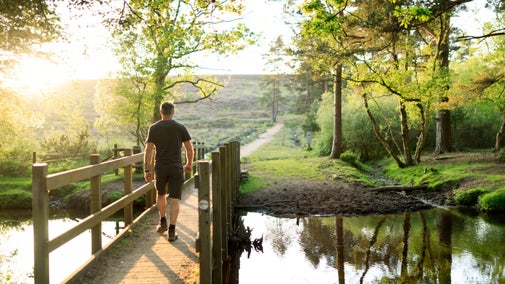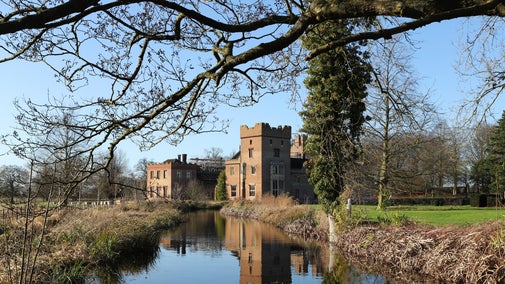
Discover more at New Forest Northern Commons
Find out how to get to the New Forest Northern Commons, where to park, the things to see and do and more.

Caring for the New Forest is a big task. Managing different areas often requires different approaches. The team works hard to ensure you can enjoy New Forest safely in ways that preserve the character of the land and protect the wildlife. Learn more about our work at New Forest Northern Commons.
New Forest Northern Commons comprise lowland heathland habitats that support internationally rare and protected specialised wildlife.
The New Forest team is dedicated to conserving and creating lowland heathland, the most declining habitat type in Europe.
Lowland heath is characterised by acid-loving heather, fine grasses, wildflowers, gorse and bogs. The terrain is the product of thousands of years of human interference. In fact, this ancient and wild terrain would revert to woodland if we didn’t give it a helping hand.
Famously romanticised in the novels of Thomas Hardy, it once cloaked vast stretches of England. Today, it’s an international rarity, with less than one sixth surviving. The New Forest’s heaths are considered some of the finest in Europe.
Most of our work involves managing the heather and gorse, which supports heathland wildlife through controlled burning, cutting and tractor mulching. This work is done using rotational management, resulting in a diverse age structure of heathland throughout our commons.
The result is a landscape rich in wildlife, providing a haven for over half the UK’s dragonfly species, as well as all six UK species of reptile.
You’ll see the results of our work every summer, when once again these fragile heaths are transformed into seas of rich purple heather dotted with yellow gorse, and alive with the gentle hum of insects.

We must also control non-native and invasive species. Rhododendron and turkey oak are two non-native species that we try to eradicate from the commons as they pose a threat to native priority habitats.
We also manage the spread of bracken, birch and pine, all of which can encroach and become invasive on heathland.
In winter the most important job is to remove birch and pine seedlings so they don’t seed into wet areas and dry them out. We coppice gorse and burn small areas of heather on a rotational basis, to retain scrub of different ages.
Older gorse makes good perches for birds like the Dartford warbler whereas butterflies, like the silver-studded blue, love young flower-rich gorse and heather. It also provides cover for ground-nesting birds such as the nightjar and reptiles like the adder.
In the New Forest, gorse is known as ‘furze’ and its coconut-scented flowers are an important nectar food source for insects such as bumblebees.
Grazing animals – cattle, sheep, ponies, even pigs – play a vital role too. Here in the New Forest the prehistoric marsh clubmoss thrives in boggy ground poached by cattle. Soil rooted by pigs is home to the critically endangered small fleabane plant.
The cutting of trees by the team can appear destructive, but these important management practices are undertaken to protect the rare heathland for years to come.
The New Forest heaths make up three-quarters of lowland heaths in Europe. Due to its rarity, and that of the wildlife it supports, the land we manage is part of a designated SSSI (Site of Special Scientific Interest).
This means that we have a statutory duty to protect and manage the heathland, keeping it free from invasive species such as pine, rhododendron, turkey oak and birch.
Lowland heath provides a home to some of the UK’s most endangered wildlife that is unlikely to survive in any other landscape, including the smooth snake and tiger beetle. It also supports no less than 5,000 species of invertebrates.

By removing some of the invasive tree species, we can protect this internationally threatened landscape and its wildlife. If we allow trees to colonise it, then it will be lost, along with the internationally rare species it supports.
The thin lowland soils found in the New Forest are peat-producing and act like carbon ‘pools’, locking away large quantities of carbon. Tree species left to grow on these sites would eventually degrade and dry out the soil, releasing the carbon into the atmosphere.
So, where lowland peat soils exist, we should do whatever is necessary to keep them intact and healthy, to prevent carbon release. The larger and less fragmented this habitat is, the more effective and resilient it will be as a carbon store.
The New Forest is the most complete interconnected landscape of lowland heathland habitats in western Europe.
With your ongoing support, we're able to continue our vital conservation work. Thank you for helping to protect these special places.

Find out how to get to the New Forest Northern Commons, where to park, the things to see and do and more.
The New Forest has a long history that dates back almost a thousand years. Humans have been living within, changing and sustaining the forest since the Bronze Age.

Discover the New Forest Northern Commons. With plenty to explore, find out more about what you might see on your next visit.

There are plenty of opportunities to volunteer at the New Forest Northern Commons. Discover how you can get involved and help to support rare habitats and wildlife.

We believe that nature, beauty and history are for everyone. That’s why we’re supporting wildlife, protecting historic sites and more. Find out about our work.

Read about our strategy, which focuses on restoring nature, ending unequal access and inspiring more people.
